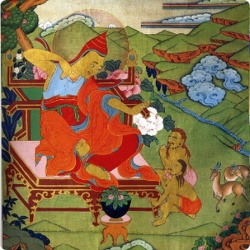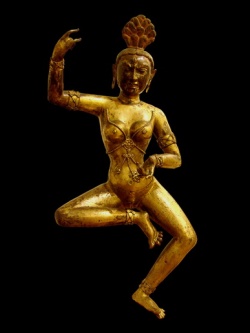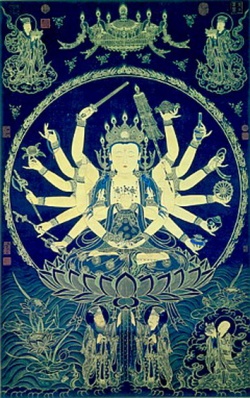Dharmakirti’s logic
Dharmakirti’s logic is an excellent weapon for a critical and a dialectical refutation of all beliefs unwarranted by experience. He wanted to achieve valid Knowledge through causal-sequence in our experience.
The idea of Perception has taken a new turn in Buddhism when Dharmakirti says that the reality rather “ultimate reality” can be known only by penetrating deep into the nature of things.
In Nyaya Bindu -
“Pratyaksa means the sense-organ is approached, reposed upon. Kalpana or Imagination is function of constructive Thought which results in Pratyaksa. So the Perception may be defined as “Saksat-kara-Vyapara - Vikalpena anugamyatte”.
Perception, Scripture and Reasoning are regarded as the usual ways of knowing object in this period. As Buddhism arises from phenomenology therefore Perception of object is important. To establish the logical validity of universal proposition (Vyapti) which reveals a concomitance between hetu and anumeya (sadhya), Perception of object is necessary because the above concomitance is impossible unless both are in principle of observables (indriyo gochar). Such Perception of object is present in our experience in a causal chain. Though the separate elements (dharmas) are not connected with one another by spatio-temporal structure but there is a connection between them. Their manifestation is subject to the laws of causation.
Dharmakirti introduces imagination when he defines Perception as a process where sensation is followed by construction (imagination). He says that Perception which is derived from senses etc. is free from pre-conception (Kalpana) and devoid of error (abhranto).
In Nyaya Bindu imagination or Kalpana primarily means “arrangement” (Yojana) and “Vikalpa” which means choice or dichotomy is used in the sense of imagination.
His idea of imagination is connected with his theory “apoha”. As Dharmakirti says that Perception which is free from pre-conception or error only can refer the experience or Perception of object, so he distinguishes imagination and Perception. For him Perception of object is only possible by negating false Perception, i.e., imagination.
Dharmakirti explains the entry of imagination in Perception. Construction is the function of imagination when we have a perceptual judgment concerning the presence of an object. Our synthetic or constructive Thought conceals its proper functions and gives prominence to the function of direct presentation. Therefore wrong Perception which is the result of imagination according to Dharmakirti comes before real Perception of an object and stand for a cause of “non-object” or non Knowledge or ‘aprama’ (invalid Knowledge).
When we are free from such wrong Perception or imagination by our understanding (Vidya) then only real object (vastu) appears to us. Thus eliminating this imaginative Perception we can see real object.
Therefore Perception or P = ~(~p). (Here (~p) is non object or imaginative object.)
Though the negative meaning of ‘apoha’ directly meaning a concept or a universal, indirectly refer to the particular real thing. It is “negation” in the sense that it is a “negation” of the whole of the unreal object. For the Buddhists unreal is non-efficient. It is fiction. Pure fiction of productive imagination is not ultimate reality. For example - A Fire which is absent which is imagined and neither really burns nor cooks - nor shades any Light is an unreal Fire. It produces a vague, abstract, general image. When an image is objectified and identified with some point of external reality, it receives an imputed reality.
From this point of view the objects can be distinguished in real and unreal substances, and in real and unreal attributes. The objects which are unattainable by space and time, are uncognisable.
Understanding is the unsensuous source of Knowledge according to Dharmakirti and it includes only different kinds of constructions which are dialectical or self-contradiction. In Buddhist logic Knowledge is possible only through direct Perception.
P = (~~p)
Thus the ultimate test of Truth of reality is the absence of contradiction.
Dharmakirti introduces theory of “apo-ha” as a key to Knowledge of real object. So the Knowledge of object is the outcome of the theory. According to Dharmakirti appearance is not reality and apprehension of object is possible through valid Knowledge which is the result of the co-ordination between hetu and anumeya.
To be conscious of an object means to be conscious of its image which has been evoked by the object.
For him Pramana is Pratyaksa and pratyaksa means non-constructive as well as non illusive. Non-constructive means not to have the nature of an arrangement and non-Illusion means ‘real’ which is opposite to Illusion. Here ‘Illusion’ means that the object is not reached upon the Mind.
Thus ‘real’ in Perception is being interpreted by Dharmakirti by dissociating or negating Kalpana.
In Nyaya Bindu “negation” is explained as ontological negation (arthamaka) which is the positive substratum of a negative concept. They can express something only dialectically, i.e. in couples of mutual negation. Therefore “negation” of unreality means that pure reality which is without the slightest bit of imaginative construction and is established on a firm foundation of objective reality and is called phenomenal World.
In Buddhism, negation stands for “eradication” of the object or annihilation. It is not like ex-nihili-nihil-fit (French word which means out of nothing comes). Here nothingness is the cause of something real.
As our cognition of fictitious objects are derived from conceptual construction or (Vikalpa) so it must be erroneous.
The Buddhist theory of error is known as asatkhyativada whether the Nyaya theory of erroneous cognition is known as anyathakhyativada. For them the object of erroneous is not totally fictitious.
But according to Buddhists an error consists in making an unreal appear as real. So they apply the theory of ‘apo-ha’.
The elimination of desire is related with the theory of “apo-ha”. Because as the Buddhists believe that all Suffering comes from Craving and that we shall cease to crave and thus may be free from Illusion.
Craving is the attempt to have what we do not and can not possess; and to be what we are not and can not be. Such Craving is exclusively one’s own. It can be eliminated through one’s own free act-and without the continuing support of Craving, Suffering would soon cease. According to Buddha the exhaustion of Craving is Nirvana.
Therefore in Nyana Bindu positively the real is efficient or arthakriyakari and negatively it is non-ideal (Winikalpa).
Thus the Perception is “Saksat-Kara-Vyapara-Vikalpena anugamyatte”.


